
A stuffy nose, a slightly open mouth, a nasal voice, mucous green discharge - no, probably, in the world of parents unfamiliar with these classic symptoms of a child's cold. Why do children more often than adults experience this unpleasant affliction? The root cause is the peculiarities of the structure of the child's respiratory system: respiratory organs of up to 12-13 years have not only smaller dimensions, but also differ in the revealed incompleteness of the anatomical structure. A child's runny nose is not a harmless disease, which can be neglected: if it can not be cured in time, the illness can take a long and even chronic form.
For what reason the child does not have a runny nose and cough, you can learn from this article.
Content
- 1 reasons
- 1.1 Vasomotor rhinitis
- 1.2 Sinusitis
- 1.3 Allergic rhinitis
- 1.4 deviated septum
- 2 Features of treatment of a protracted rhinitis in children of different ages
- 2.1 Children under one year
- 2.2 Children from one year to three
- 2.3 Children from three years
- 3 Opinion of Dr. Komarovsky
Reasons for
What are the time limits for treating rhinitis considered normal? The usual inflammatory process, caused by a viral infection, can "be defeated" over a period of five to seven days, depending on the age of the patient.
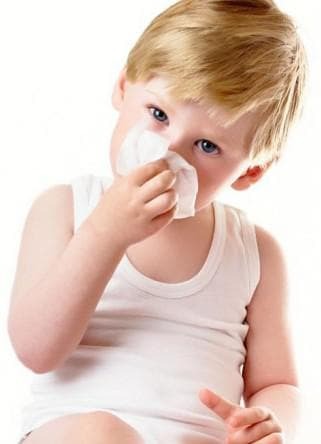
In some cases, when it comes to weakened immunity and diseases caused by bacteria, it can last up to ten days. If after this time the child is still suffering from discharge from the nose - a runny nose is considered protracted. That is, if it's been a month already, it's worth thinking about the reasons.
What to do when an adult does not have a runny nose 2 weeks, you can learn from this article.
Prolonged rhinitis is by no means always the evidence of negligence of parents. Even with a responsible approach to the problem, the illness may not leave the baby for a long time, creating difficulties with breathing, sleeping, eating, badly affecting memory and mindfulness. Often this is due to an incorrect diagnosis and incorrectly prescribed treatment.
It is unmistakable to determine what caused prolonged rhinitis in a child, only an ENT doctor based on tests will be able to, but there are also external differences that will help parents navigate in the complex classification of this disease.
How is cough and coryza treated in infants treated, you can learn from this article.
Vasomotor rhinitis
The most common complication of a common, provoked by a viral or bacterial infection, is a runny nose. The reason for it, surprisingly, is not the absence of treatment, but, on the contrary, the abuse of it. Vasomotor rhinopathy appears due to overly prolonged treatment with vasoconstrictor drops that facilitate the patient's condition and allow him to breathe, but adversely affect the condition of the vessels. Symptoms of the disease:
- alternate laying of the nostrils( especially evident when lying on its side).If the patient lies on the right side of the body, then the right nostril will be laid down and vice versa;
- the appearance of mucous secretions and nasal congestion with a sudden change in temperature( for example, if you enter a warm room from a frost);
- sleep disorders;
- headaches;
- nasal lining under stress, nervous tension( because of this symptom, vasomotor rhinitis is often called a neurovascular rhinitis).
From this article you can find out what to wash your nose with a child with a cold.
Another name for the disease - a false runny nose - was given to her for the fact that she often appears with the complete absence of a viral infection. In this case, the nose can "lay" due to hormonal changes( pregnancy, menstruation, menopause, thyroid problems), external stimuli( odors, dust, smoke), sudden changes in the weather.
Timely diagnosed, this type of disease is easily treatable, otherwise it can cause complications such as otitis and sinusitis.
The video discusses the situation when the child does not have a runny nose:
For what reason the child has 3 years of a common cold and cough, you can learn from this article.
Maxillary sinusitis
Inflammation of the maxillary sinus or sinusitis is a consequence of an untreated rhinitis. The maxillary sinuses are located next to the nose, on either side of it, and are designed to warm and filter the air coming through the nose. They are directly related to the nasal cavity and during the runny nose, too, are affected by inflammation. With the timely and adequate treatment of sinusitis passes simultaneously with rhinitis, but if the disease can start to run into a chronic condition. Determine the disease can be on the following symptoms:
- nasal breathing disorder;
- "deep" nasal congestion, not always accompanied by a runny nose;
- headache, concentrated in the region of the frontal( above the inner edges of the eyebrows) and maxillary sinuses;
- olfaction impairment;
- sensitivity to light.
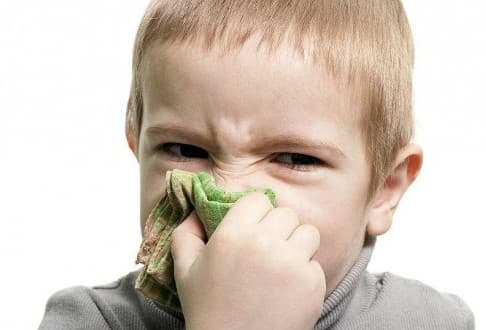
The disease is treated with antibiotics, regular flushing, warming, physiotherapy( electrophoresis, ultrasound, inhalation).In rare cases, surgical puncture and flushing in the hospital may be necessary.
What to do when laying an ear with a runny nose, you can learn from this article.
Allergic rhinitis
This ailment affects children more often than it may seem at first glance, but most parents lastly admit the possibility of an allergy in their child. After all, they try to feed it only with natural farm products, spend several hours a day in the park, and there are no allergic people in the family - where to get such an affliction?
In fact, everything is not so simple the human body lends itself to an attack of external stimuli every second. This can be household dust, wool and pet food, pollen, household chemicals, children's cosmetics, and food. The body of a healthy person copes with these attacks, but in case of reduced immunity or disturbed metabolism begins to signal that he needs help. The main danger of allergy is that it can develop into bronchial asthma, so the seemingly innocuous allergic rhinitis must necessarily be treated.
What kind of pill from the cold is best to take, you can learn from this article.
Symptoms of rhinopathy:
- persistent liquid clear discharge from the nose;
- frequent paroxysmal sneezing;
- redness and tearing of the eyes;
- nasal congestion;
- itching in the nose.
The video tells about the reasons why the runny nose does not pass in the child and what to treat it:
Is it possible to walk with a child with a common cold, specified in this article.
The treatment regimen for each child is developed individually, depending on the course of the disease and the patient's age. First and foremost, it is the control of the child's environment by excluding potential allergens from food and maintaining cleanliness in the room. From the appointment of antihistamines, doctors as far as possible try to refuse, because this type of medicine is not well tolerated by all children.
Curvature of nasal septum
Nasal septum is a cartilaginous thin wall that divides the human respiratory organ into two cavities. The cause of its curvature may be uneven growth of the skeleton, trauma, uneven patency of the nasal passages. Symptoms of pathology are similar to those of rhinitis, but snoring, whistling, or other sounds that indicate nasal breathing are usually added to them. It is treated with a simple surgical operation, the decision about necessity of which is taken by the ENT doctor, having weighed all the factors.
What children's nasal drops are best to apply from the cold, is indicated in the article.
The video describes the situation if the runny nose does not pass for a long time in an adult:
Features of treatment of prolonged rhinitis in children of different ages
Despite the fact that doctors strongly do not recommend parents to engage in self-treatment of children, even in the case of normal rhinitis, most moms and dads tend to consult a doctor already when the runny nose lasts two weeks or more. In the fight against children's snot in the course are the first ones that came to hand funds left over from the previous illness drops, tablets recommended by the pharmacist in the nearest pharmacy, an ointment that helped the baby neighbor. How many complications( and often extra costs) could be avoided with timely access to the pediatrician. But even if the diagnosis is correct right away, each age group of children has its own characteristics, which do not allow treating them according to one well-developed scheme.
How to properly apply aloe juice from the common cold is indicated in this article.
Children before the year
Rhinitis in the youngest patients is a common phenomenon. If the baby's cold does not go away, it is often due to the fact that the infant's respiratory system is imperfect, the nasal passages are too small and narrow. In this regard, newborns can have a physiological runny nose, the cause of which is the adaptation after childbirth. In the womb, he was in a humid environment and did not know what temperature changes were, and after the birth he met dust and dry air, and began to learn to breathe through his nose. Because of this, the nasal passages of the child are overdried, which gives "green light" to the bacteria and viruses that enter them. 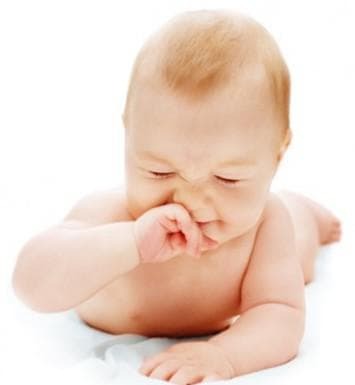
To prevent physiological rhinitis, it is necessary to carefully clean the spout from the very birth with the help of twisted sterilized turuns( in no case, cotton buds!) And irrigate with ready-made hygienic solutions sold in the pharmacy( Otrivin Baby, Humer, Aquamaris).Burying breast milk in the nose is not worth it in spite of widespread misconception, it does not possess disinfectant properties, but it is a fertile environment for the reproduction of pathogenic microorganisms.
To treat a baby from the cold can not do it on its own if the speech is still about a viral rhinitis, the infection can spread to the bronchi and lungs in a matter of hours, and this is fraught with very bad consequences.
Children from one year to three
This category of patients can no longer suffer from a physiological rhinitis, but is often susceptible to viral and allergic ones. At the age of 1 3 years, prolonged rhinitis may become an additional factor for the occurrence of diseases such as otitis, tonsillitis, laryngitis. Treatment is complicated by the fact that the child can not empty his nose by himself and rinse it with saline solution, therefore cleaning the nasal passages from mucus is the task of the parents. For this, an aspirator is used, consisting of a rubber pear, to which a plastic tip is attached. He works at the expense of vacuum and allows you to quickly return the child the opportunity to breathe fully nose. 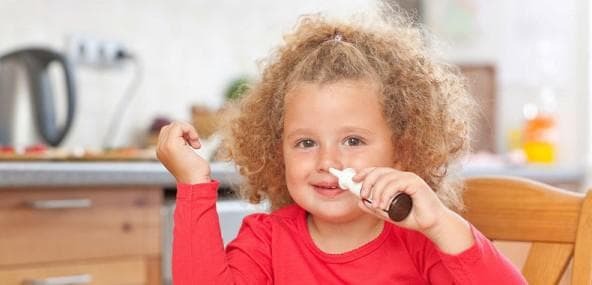
Not recommended at the age of three years to use essential oils and various herbal infusions, they can cause allergies, which will exacerbate the condition of the patient.
Children from three years old
When treating rhinitis in patients older than three years, doctors try to use a minimum of medications. If the disease is not allergic, emphasis should be placed on the so-called folk remedies: heating of the maxillary sinuses with a hard-boiled chicken egg, a bag of heated large salt, potatoes "in uniform".Warm up to clear to moisten here is the algorithm by which the cold should be treated at this age. Naturally, with the approval of the doctor. 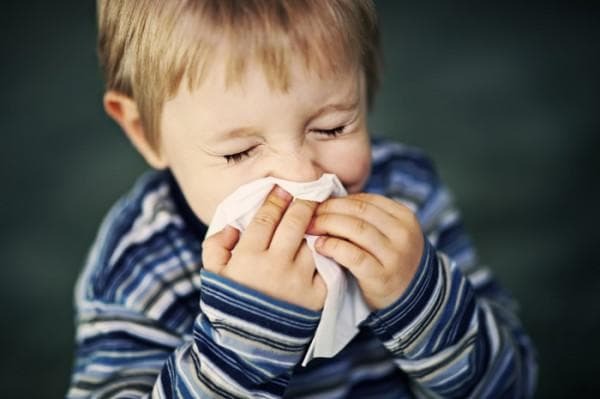
Opinion of Dr. Komarovsky
What if I can not get rid of the "leak" from the nose for a long time? Just like most pediatricians, Dr. Komarovsky first of all insists on finding the cause of the common cold. We already know that most often it can be a virus or an allergen. Accordingly, the treatment should not be aimed at eliminating the symptoms, but not eradicating what caused them.
In viral rhinitis, mucus that forms in the nose is a natural environment that helps to destroy harmful microbes and prevent their penetration further into the respiratory tract. The main task of parents is to keep the humidity level at least 70%, so that the mucus can remain viscous. You can do this in any accessible way, often wash the floors and wipe the dust, turn on the humidifier, open the windows, provide ample drinking. Do not be afraid of fresh air: if the cold is not accompanied by fever, in any weather and at any time of the year the child can and should be taken out for a walk. Walking, of course, should be away from other children, so as not to promote the spread of infection.
The video tells why the child does not have a runny nose for a long time:
You can use vasoconstrictive drops, as prescribed by the doctor, while always following the rules:
- In accordance with the instruction, strictly follow the dosage( if written three times a day, this should not befour or five simply because the drug temporarily clears the nose and brings relief);
- do not use the medicine for more than seven days;
- buy children's forms of the drug, containing active substances in a lower concentration;
- to abandon the use of drops, if there were side effects( increased heart rate, shortness of breath, itching in the nose, etc.).
If lingering rhinitis wears is allergic to , it is important to get rid of its source. If possible, you need to change the situation to take the child to the cottage, to the village, to the grandmother and grandfather, to the sea. At this time, to clean the apartment, because the most common cause of allergic rhinitis is household dust and animal hair. I'll have to say a hard "no" to carpets, paths, feather pillows and blankets, napkins, fabric shades and panels. If the allergy appears often the apartment will have to be equipped with a cleaner and air humidifier. If the allergy causes seasonal flowering and there is no way to remove the child for this period, you will have to take advantage of special sprays and antihistamines prescribed by the treating doctor.
